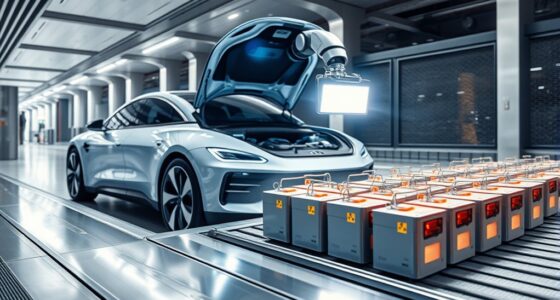To understand BEV versus FCEV efficiency, examine how each vehicle converts energy. BEVs store electricity in large batteries, which power an electric motor directly, but their weight can reduce efficiency and range. FCEVs generate electricity on-board through hydrogen fuel cells, offering quicker refueling and lighter weight, which can boost performance. Exploring these energy paths reveals why FCEVs often have advantages in refueling speed and weight-related efficiency—keys to their real-world use.
Key Takeaways
- BEVs convert electricity stored in batteries directly to power, involving energy losses during charging and discharging processes.
- FCEVs generate electricity on-demand through hydrogen fuel cells, with energy losses during hydrogen production, storage, and conversion.
- Battery weight in BEVs affects overall efficiency by increasing vehicle mass and energy required for movement.
- FCEVs benefit from lighter weight due to absence of large batteries, improving handling and reducing energy consumption.
- Refueling speed impacts efficiency and practicality, with FCEVs refueling quickly and BEVs relying on slower charging methods.

When comparing battery electric vehicles (BEVs) and fuel cell electric vehicles (FCEVs), efficiency plays a crucial role in determining their practicality and environmental impact. One key factor to weigh is battery weight, which directly influences the vehicle’s efficiency and handling. BEVs rely on large batteries to store energy, and these batteries tend to be quite heavy. This added weight can reduce overall efficiency because it increases rolling resistance and demands more energy to accelerate and maintain speed. While advancements have made batteries lighter and more compact, the weight still affects the vehicle’s range and energy consumption. Conversely, FCEVs use a hydrogen fuel cell to generate electricity on demand, which means they don’t carry heavy batteries. This results in a lighter vehicle overall, often translating to better handling and, in some cases, improved energy efficiency.
Refueling speed is another critical aspect that influences efficiency and usability. BEVs typically require longer stops to recharge, often taking 30 minutes or more with fast chargers, and even longer with standard chargers. This extended refueling time can diminish the practicality of BEVs for long-distance travel or daily use where quick turnaround times are essential. On the other hand, FCEVs can be refueled in about 3 to 5 minutes, similar to conventional gasoline vehicles. This rapid refueling substantially enhances their practicality by reducing downtime, making them more appealing for drivers who prioritize convenience and minimal interruption. The ease of refueling also impacts energy efficiency indirectly; shorter refueling times mean less energy is wasted during charging, and the vehicle can operate more continuously. Additionally, understanding energy conversion paths offers insight into how each vehicle type utilizes different technologies to achieve efficiency.
When you evaluate these factors, the efficiency of BEVs and FCEVs depends heavily on your driving patterns and priorities. If you mostly drive short distances and can plan for longer charging sessions, the heavier batteries of BEVs might not be a major hurdle, especially as battery technology improves. However, if you need quick refueling and prefer lighter vehicles, FCEVs offer a compelling advantage. Keep in mind that the efficiency of either vehicle type also depends on other factors like infrastructure, maintenance, and how energy is generated or sourced. But fundamentally, understanding the impact of battery weight and refueling speed helps you grasp why each vehicle type performs differently in real-world conditions and how they fit into different lifestyles and needs.
Frequently Asked Questions
How Does Battery Degradation Affect BEV Efficiency Over Time?
Battery degradation reduces your BEV’s efficiency over time by diminishing its battery lifespan and capacity. As degradation effects set in, your vehicle can’t hold as much charge, leading to decreased driving range and longer charging times. You might also notice increased energy consumption during acceleration and driving. Regular maintenance and mindful charging habits can slow degradation, helping you maintain peak efficiency and extend your battery’s lifespan for as long as possible.
What Are the Environmental Impacts of FCEV Hydrogen Production Methods?
You might think hydrogen fuel cell vehicles are eco-friendly, but their production methods have serious environmental impacts. If hydrogen is made from fossil fuels, it causes massive water usage and releases greenhouse gases. Plus, hydrogen leakage during production and transport can substantially worsen climate change. So, while FCEVs seem clean, their environmental footprint depends heavily on how the hydrogen is produced, making sustainability a real challenge.
How Do Cold Weather Conditions Influence BEV and FCEV Performance?
Cold weather conditions affect both BEV and FCEV performance by reducing battery efficiency and hydrogen fuel cell output. You’ll notice decreased range and longer warm-up times. To counter this, you should rely on thermal management systems and insulation techniques that keep components warm. Proper insulation helps maintain ideal operating temperatures, ensuring your vehicle performs reliably in cold climates without sacrificing too much efficiency or comfort.
Can Renewable Energy Sources Fully Power FCEV Hydrogen Generation Sustainably?
Think of renewable energy sources as a steady river feeding a mighty dam. Yes, they can fully power FCEV hydrogen generation, but only if renewable integration is seamless and sustainability challenges are addressed. While promising, relying solely on renewables requires overcoming intermittency and storage issues. With careful planning and innovation, you can harness this river sustainably, ensuring hydrogen production supports a cleaner, greener future.
What Are the Long-Term Cost Implications of Maintaining BEV Versus FCEV Systems?
You’ll find that maintaining BEV systems generally has lower long-term costs due to minimal upkeep and no fuel expenses, though you’ll need to budget for battery replacements. FCEVs might incur higher costs because of complex fueling infrastructure and hydrogen production costs, but they could last longer with less frequent battery replacements. Over time, BEVs tend to be more economical, but infrastructure investments for FCEVs could balance out initial expenses.
Conclusion
Think of BEVs and FCEVs as two different rivers flowing to the same ocean. BEVs glide smoothly along electric currents, while FCEVs tap into the hydrogen stream, both seeking efficiency. Your journey depends on your destination—whether you prefer the steady stream of battery power or the dynamic flow of hydrogen. Understanding their paths helps you choose the vessel that best carries you toward a cleaner, sustainable future. Ultimately, both rivers lead to progress.









